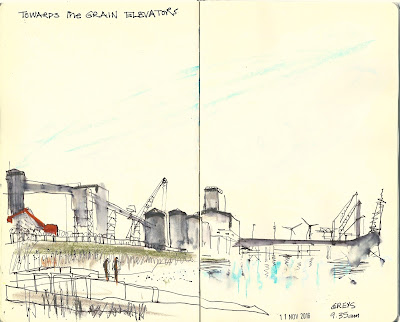 |
| Tilbury Breakfast |
 |
| Stations in the Sun |
Tilbury
Another
coastal jaunt with Trevor, this time on the north sided of the Thames Estuary,
to Tilbury.
 |
| Across the the minarets of Gravesend |
 |
| Travelling through Tilbury |
Tilbury
was established in the late 1800s near a 16C fort, built by Henry VIII and
ancient cross-river ferry. The ferry still runs to Gravesend. As we gazed
across the Thames, the sun came up on its minarets.
Tilbury
has a major deep-water port, and it contributes to ‘Tilbury Docks’ rhyming
slang for socks (As in “a nice pair of Tilbury's”).
The
narrowness of the Thames here made it a suitable place to construct forts for
the defence of London against foreign invaders. Further along the waterfront
two power stations were enjoying the sun, Tilbury A Power mothballed 1981, and
Tilbury B was still going up until 2013
Doubling
back upstream a couple of miles we reached Grays Beach Riverside Park. This was
an extraordinary public space, with a huge sandpit, play galleon, skate ramp,
an aerial zip-line, ‘multi-use ball court’ plus ‘a large open grass field,
ideal for picnics’. Not quite so tempting in November. The website also advised
that the café is closed until further notice, and regretted that no public
toilets or baby change facilities are available within the park but apologised
for any inconvenience caused.
 |
| From Grays Beach |
Coal
House Fort
Lord
Palmerston, twice Prime Minister twice during the 19th century was keen to
promote the idea of a defensive wall around the British Isles to protect us
from the perceived European threat. Coal House Fort, a few miles to the East,
was part of the plan. And it served in both World Wars. In WW2 the Royal
Artillery, Royal Marines, Essex Home Guard, Royal Navy, the R.N.V.R and W.R.N.S
were all stationed at Coal House. It is easy to imagine the stream of traffic
to and from Whitehall along the A13 into Essex
 |
| Coal House |
Our
final port of call (no pun intended) was the former The Bata shoe factory in
East Tilbury. This building is all that remains of an industrial estate in
Essex, which produced shoes for over 70 years. Founded in 1932 by Tomáš Baťa,
from Czechoslovakia.
In 1933
he added Bata houses for workers were built, set among gardens, shops and
public buildings in the modernist style. "Bata-ville" had all the
services of town, including a theatre, sports facilities, hotel, restaurant,
grocery and butcher shops, post office, and a newspaper.
 |
| Bata-ville |

No comments:
Post a Comment
Thank you very much for your comments - Tim